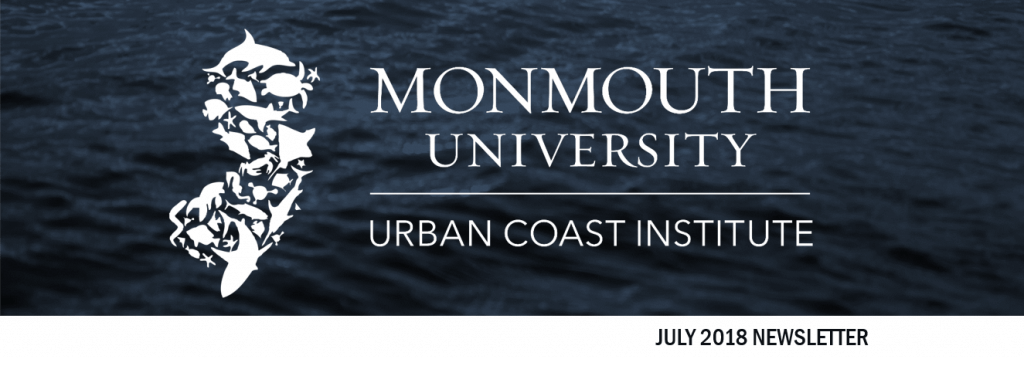
Monmouth University Unveils 49-Foot Research Vessel Nauvoo
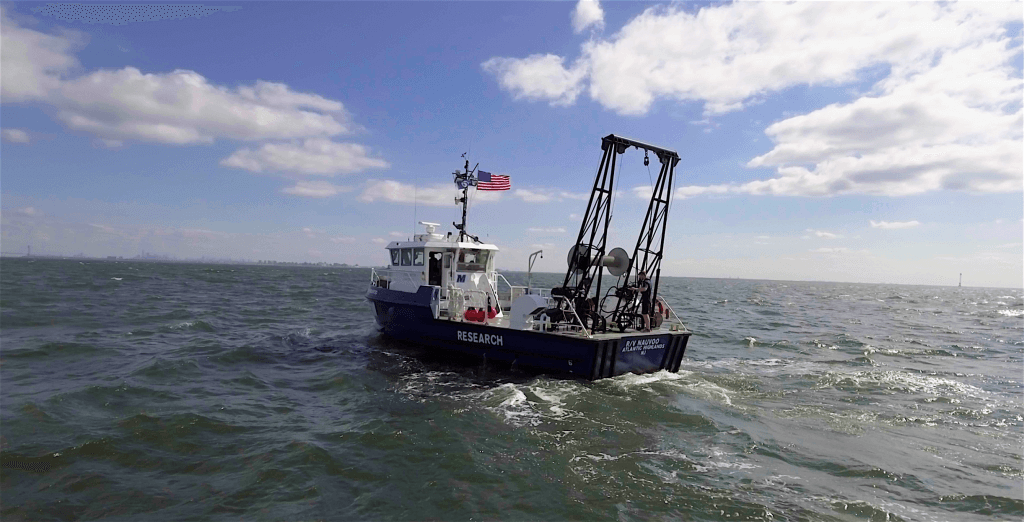
Monmouth University leaders, faculty and students were joined by state and federal officials on June 27 to unveil the newest and largest member of the university’s research vessel fleet – the 49-foot Nauvoo.
The acquisition of the Nauvoo will enable the UCI to conduct research, educational and contract work at a larger scale than ever before. It will also substantially enhance in-house research and monitoring capabilities to meet increasing faculty and student demand within the School of Science’s Marine and Environmental Biology and Policy Program.
The vessel will make it possible to take full classes and large groups on the water and work on the open ocean up to 20 nautical miles offshore. Overnight research trips on the water are now possible, as the vessel has a head and the capacity to berth seven.
“Few universities throughout the East Coast have a research vessel of this class,” Monmouth University President Grey Dimenna said. “The Nauvoo will advance our growth as a premier marine research and policy center in the region. For students interested in marine science, this is yet another great reason to come study at our beautiful coastal campus.”
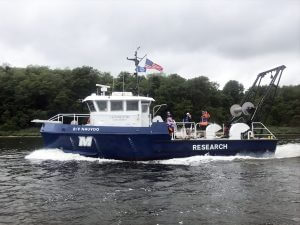 The Nauvoo is outfitted with state-of-the-art technologies including a side-scan sonar system that provides highly detailed views of underwater terrains. The vessel will provide critical support for in-house scientists and students, and additional capacity to work collaboratively with government agencies, academic institutions and NGOs on areas of critical concern such as oyster restoration, shore erosion and channel shoaling.
The Nauvoo is outfitted with state-of-the-art technologies including a side-scan sonar system that provides highly detailed views of underwater terrains. The vessel will provide critical support for in-house scientists and students, and additional capacity to work collaboratively with government agencies, academic institutions and NGOs on areas of critical concern such as oyster restoration, shore erosion and channel shoaling.
Originally built as a U.S. Coast Guard buoy tender, the Nauvoo was later transferred to the National Oceanic and Atmospheric Administration (NOAA), which provided it to the University in 2017 at no cost. The vessel has since undergone extensive maintenance and improvement work. It joins two smaller UCI-maintained vessels that have long served the university’s primary marine field operations and research needs – the 18-foot Little Hawk and 27-foot Seahawk.
“We thank NOAA for this valuable contribution to the marine science and education work taking place at Monmouth University,” UCI Director Tony MacDonald said. “The Nauvoo will provide students with a truly transformational learning experience, and further advance the UCI’s mission to develop the best available science to support healthy and productive coastal ecosystems and sustainable communities.”
“We are thrilled to help support Monmouth University’s developing marine research program with the donation of our 49-foot research vessel, R/V Nauvoo,” said Jon Hare, director of NOAA’s Northeast Fisheries Science Center, which includes the NOAA Sandy Hook Laboratory.
The Nauvoo will provide the university with a platform for expanding collaborative research with NOAA and other universities and regional partners. “We are very pleased that the vessel will continue to play an important role in our strong and growing cooperation with Monmouth University in pursuit of our shared vision to responsibly manage our marine resources,” Hare said.
Among the current university projects the vessel will aid are a probe of sediment contamination in New York Harbor; ongoing research on distributions and behaviors of the endangered Atlantic sturgeon and sharks off the New Jersey and New York coasts; collaboration with Rockefeller University on testing regional waters for environmental DNA (eDNA) fragments that can confirm the presence of fish and other marine organisms; studies of harmful algae blooms in coastal waters; water quality monitoring and testing; and fisheries surveys for state and federal agencies.
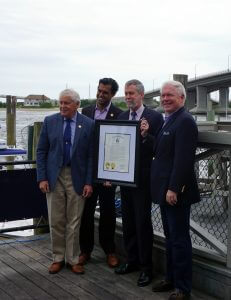 New Jersey State Sen. Vin Gopal and Assemblyman Eric Houghtaling, who represent the coastal district that includes Monmouth’s West Long Branch campus, presented a resolution honoring the critical research work performed by the university.
New Jersey State Sen. Vin Gopal and Assemblyman Eric Houghtaling, who represent the coastal district that includes Monmouth’s West Long Branch campus, presented a resolution honoring the critical research work performed by the university.
“The first step in addressing the challenges that face the New Jersey’s marine environments is understanding them,” Gopal said. “The research that will be conducted on the Nauvoo will help inform important coastal policy decisions, while at the same time training a new generation of marine scientists.”
“It has been a pleasure to watch Monmouth University’s growth as a leader on coastal issues that continue to grow in importance for our communities, from dealing with sea level rise to understanding how pollution is impacting wildlife in our waters,” Houghtaling said. “The student body and faculty are taking full advantage of their access to the greatest laboratory in the world – the New Jersey Shore.”
View an album of photos from the press conference.
Nauvoo in the News
Below is a sample of the media coverage of the Nauvoo unveiling:
Monmouth University gets a new marine research vessel, NJTV News
Research vessel Nauvoo back in home waters, WorkBoat Magazine
Welcome aboard Nauvoo — Monmouth University’s newest research vessel, New Jersey 101.5
Monmouth University acquires aquatic research vessel, News 12 New Jersey
UCI Receives $150,000 Plangere Foundation Grant to Improve Stewardship of Coastal Lakes
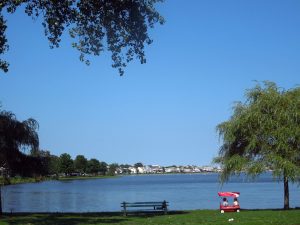
The UCI has been awarded a $150,000 grant from the Jules L. Plangere, Jr. Family Foundation to establish a Coastal Lakes Community Observing Network (CLONet) focused on improving the health of five Monmouth County lakes. Through the project, Monmouth University School of Science and UCI staff and students will partner with municipalities and community groups to organize citizen science efforts, workshops and on-campus conferences dedicated to understanding the causes of environmental problems facing Lake Como, Deal Lake, Lake Takanassee, Wesley Lake and Sunset Lake.
Monmouth County has 12 lakes along its shoreline that have historically provided a variety of recreational opportunities for residents and visitors and served as important habitats for fish and wildlife. However, intense development around the lakes has introduced pollution from stormwater drainage, litter and other sources, degrading these aquatic ecosystems. As a result, many of the county’s coastal lakes suffer from neglect, experience harmful algal blooms, and are often valued less for the natural resources and recreational opportunities they offer and more as an element of local stormwater drainage systems.
A number of coastal lake organizations and commissions have formed to preserve and restore their local lakes. The effectiveness of these organizations in achieving their goals has varied from place to place depending on the availability of funding, local interest and scientific expertise. Monmouth and UCI staff will work alongside and train members of these organizations to monitor physical (for example, depth, sediment thickness, temperature, salinity), water quality (dissolved oxygen, pH), and biological (algae, bacteria) parameters in their waters. The University researchers will also develop standardized monitoring methods and quality assurance protocols for the community groups.
“One of the goals of this project is to create more sustained interest within the communities in continuing to monitor these lakes,” said UCI Associate Director Tom Herrington, the project manager. “We really want to build a network of citizen scientists through this grant so they can become our partners into the future.”
Monmouth University Endowed Associate Professor of Marine Science Jason Adolf and students began research in the lakes this summer. The team has exposed algae samples filtered from the lakes to nutrients in the lab, then placing containers with the samples back in the lakes to see how they respond. The experiments are intended to simulate how exposure to various inorganic nutrients found in fertilizers and storm runoff might generate harmful algal blooms in the systems.
“If you know the causes of algal blooms, you can learn to predict when they’ll happen and ultimately manage them,” Adolf said.
Community workshops will be held in the five lake areas under the guidance of University faculty, staff and students to mentor each community group on the use and applications of the project’s GIS system, analysis techniques, and future restoration plan development and implementation. Water sampling data and other resources will be shared on a publicly accessible CLONet website.
Shark Week Spotlight: Tagging Smooth Dogfish
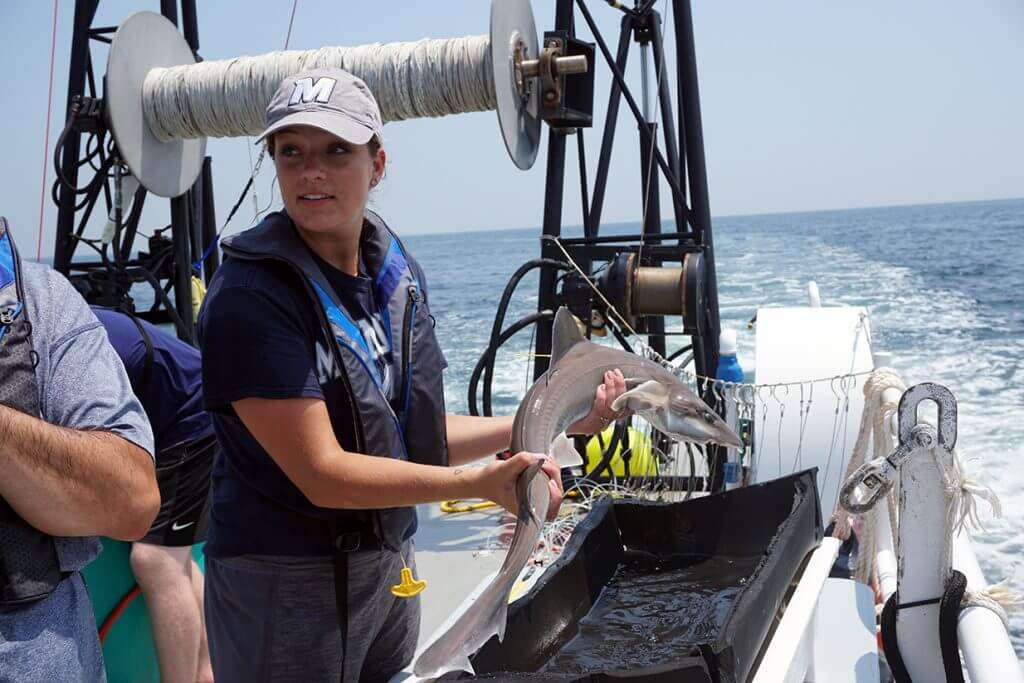
Monmouth University Assistant Professor Keith Dunton and students Lauren Kelly, Troy Ohntrup and Charlie Vasas watched as a longline baited with dozens of pieces of menhaden was slowly reeled up to the research vessel Nauvoo. One after another after another they came – roughly 20 in all.
The dogfish days of summer are here.
Known as one of the most abundant sharks in sea, dogfish certainly enjoy their summer home on the Jersey Shore. On this day, all of the animals caught were of the species Mustelus canis, also known as the smooth dogfish.
Smooth dogfish undergo large seasonal migrations. During the spring they move to the cooler waters of the Mid-Atlantic and New England, then return south during the fall to spend their winters near the Carolinas, Dunton said. The fish grow to 4 feet long on average and primarily eat crustaceans, mollusks and small fish. Like many cartilaginous fish species, smooth dogfish have long gestation times and carry their young for up to 11 months.
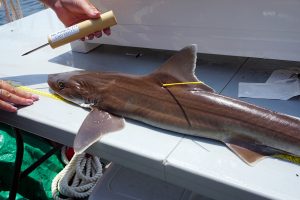 As the crew unhooked each fish, they placed them in a large tank for temporary holding before surgically implanting two-year acoustic telemetry tags. Dunton described the devices as “an E-Z Pass system for fish.” When fish swim by buoys equipped with acoustic receivers, the tags will send information such as the time, date and water conditions at the moment.
As the crew unhooked each fish, they placed them in a large tank for temporary holding before surgically implanting two-year acoustic telemetry tags. Dunton described the devices as “an E-Z Pass system for fish.” When fish swim by buoys equipped with acoustic receivers, the tags will send information such as the time, date and water conditions at the moment.
The team’s work is part of a larger project meant to examine species habitat use in areas off the coast of New Jersey and New York that are being considered for potential offshore wind farms, Dunton said. The group has also been conducting land-based fishing and tagging this summer as part of UCI-funded research into the demographics and habitats of sharks and rays along the Jersey Shore.
Dunton said beachgoers have nothing to fear from these fellow swimmers.
“Dogfish are not dangers to humans,” he said. “In fact their teeth are not sharp. They are flat and almost smooth, meant to crush and grind small prey items.”
View an album of photos from the shark tagging trip.
The students will be among several dozen on hand discussing their work at the Monmouth University School of Science Summer Research Program Symposium on Aug. 9. Additional details on the event will be posted as they become available.
Gaffney: For science and security, Trump should prioritize our oceans
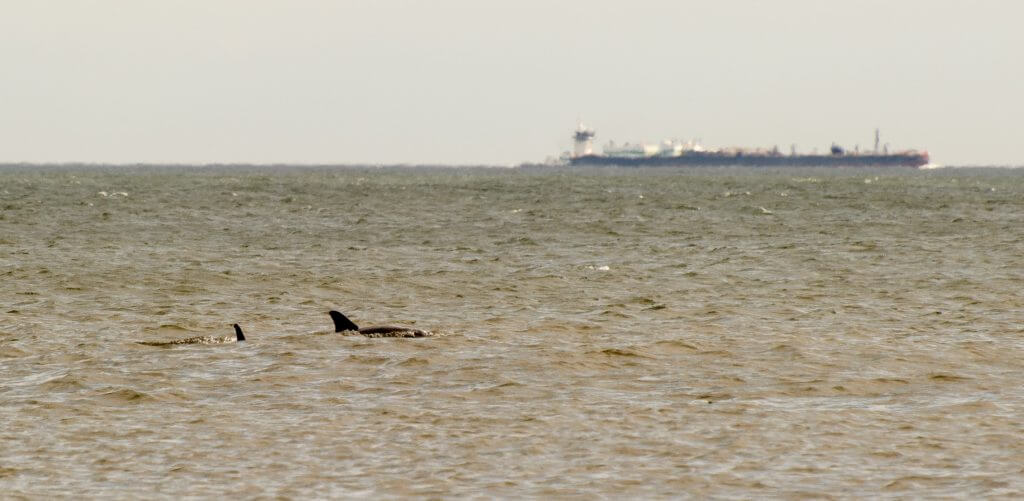
Monmouth University President Emeritus and UCI Ocean Policy Fellow Paul G. Gaffney II co-wrote an op-ed in The Hill with Ocean Conservancy CEO Janis Searles Jones on where President Trump’s new executive order on the National Ocean Policy should take us next. Read it here.
What’s New & What’s Not: President Trump’s Executive Order on Ocean Policy
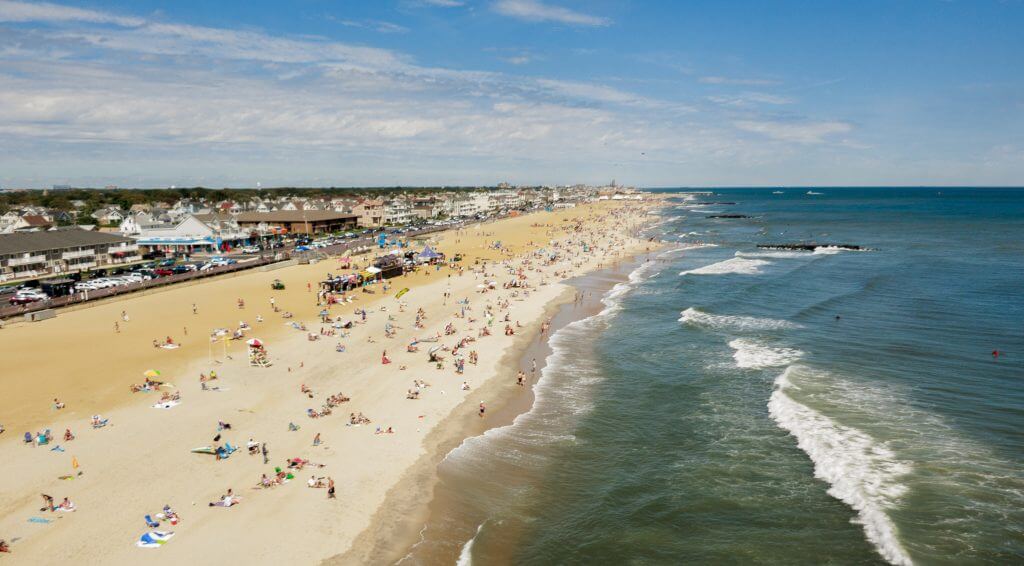
By Tony MacDonald, Urban Coast Institute Director
President Trump has issued a new Executive Order on Ocean Policy “to advance the economic, security, and environmental interests” of present and future generations. The EO revokes the Obama Administration’s 2010 National Ocean Policy EO, which is hardly surprising given that this administration has moved out aggressively on many fronts to undo virtually anything “Obama.”
In the partisan vortex of Washington, D.C., the blogosphere is already abuzz with EO spin ranging from assertions of disaster and retreat to welcome relief from previous bureaucratic overreach. The environmental community is justifiably concerned as the administration opens new areas, including the Mid-Atlantic, to offshore oil and gas drilling, threatens to reduce commitments to marine conservation, and almost daily announces rollbacks of environmental regulations. However, the ocean community is well advised not to get too caught up in semantic battles and to listen to the advice of parents taking their kids to the baseball diamonds this spring: “Keep your eye on the ball.”
Neither the current nor the previous EO creates new laws or regulations; they rely on existing laws as the foundation for interagency collaboration and ocean management. It is important to stay vigilant and focused on enforcing those laws that support conservation and protection of healthy ocean ecosystems, as well as sustainable ocean uses ― what is increasingly being referred to as the new Blue Economy. It is correct to point out that the new EO eliminates much of the language from the previous order that encouraged advancing marine conservation, and marine spatial planning, and focuses on enabling economic growth.
This shift in language should not be used to justify tipping the scales against the “environmental benefits” cited in the order and actions necessary to protect and restore the marine environment, and to hold ocean users accountable to limit their impacts. My experience working with various ocean stakeholders over the past 30 years ranging from ports to state managers to fishermen to nongovernmental organizations is that, despite their differences, they have a shared interest in stewardship of ocean resources.
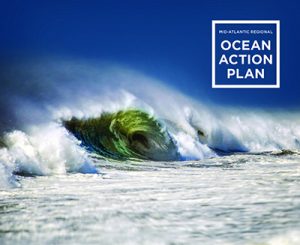 Under the previous EO, a first-ever Mid-Atlantic Regional Ocean Action Plan was certified by the White House in December 2016. A similar plan was approved in the Northeast region. For the past six years, the Urban Coast Institute has been a partner with the Mid-Atlantic Regional Council on the Ocean (MARCO) and the federal-state Mid-Atlantic Regional Planning Body (RPB) in developing a regional Ocean Data Portal ― a comprehensive online data and information resource that supports regional ocean planning and management. The biggest changes in the new order in addition to its focus on the ocean economy are the elimination of a National Ocean Council, the requirement for RPBs and the development of these regional ocean plans. This framework has been replaced with a trimmed-down federal Interagency Ocean Council with Subcommittees for Science and Technology and Resource Management, and support for federal agency participation in state-led regional ocean partnerships (ROP) such as MARCO or the Northeast Regional Ocean Council, among others. It is unclear what shape this will take and how it will impact current commitments.
Under the previous EO, a first-ever Mid-Atlantic Regional Ocean Action Plan was certified by the White House in December 2016. A similar plan was approved in the Northeast region. For the past six years, the Urban Coast Institute has been a partner with the Mid-Atlantic Regional Council on the Ocean (MARCO) and the federal-state Mid-Atlantic Regional Planning Body (RPB) in developing a regional Ocean Data Portal ― a comprehensive online data and information resource that supports regional ocean planning and management. The biggest changes in the new order in addition to its focus on the ocean economy are the elimination of a National Ocean Council, the requirement for RPBs and the development of these regional ocean plans. This framework has been replaced with a trimmed-down federal Interagency Ocean Council with Subcommittees for Science and Technology and Resource Management, and support for federal agency participation in state-led regional ocean partnerships (ROP) such as MARCO or the Northeast Regional Ocean Council, among others. It is unclear what shape this will take and how it will impact current commitments.
Ocean stakeholders need to be diligent in working with administration and federal agencies as they move to develop guidance and implement the EO. What, for example, is meant by language in the order indicating that it is US policy to “ensure that Federal regulations and management decisions do not prevent productive and sustainable use of ocean, coastal, and Great Lakes waters”? The order directs federal agencies within 90 days, to review their regulations, guidance, and policies for consistency with the order.
These changes leave the Mid-Atlantic Regional Ocean Action Plan in a bit of Limbo. It would be very regrettable if the many years of hard work and extensive stakeholder involvement that led to the adoption of the Plan were to be undone. Rather, we should find a way to build on the interagency and intergovernmental coordination efforts, substantial progress that has been made in building relationships, and the consensus actions identified. The actions in the Plan can and should be recommitted to under the framework of the new EO and a new process for federal-tribal-state coordination and collaboration with the ROP’s be established so that progress can continue, and new opportunities identified.
The new EO’s commitment to the improved public access to marine data and information, and common information data systems such as the Marine Cadastre, reflects a clear endorsement of and continued support for the Mid-Atlantic Ocean Data Portal. Continued collaboration among the federal agencies and the state regional partnerships on the development of data and information will enable us to identify and map ocean resources and uses that can help us better understand potential conflicts and inform ocean management decisions. This is nowhere more important than the Mid-Atlantic, where proposals for extensive offshore wind development are gaining traction, marine transportation carries more cargo on ever bigger ships, whales are returning and ecotourism expanding, and fishermen are concerned about their livelihood and continued protection of critical fishing areas.
The EO’s specific focus on ocean science, dissemination and exchange of information to coordinate and inform the ocean policy-making process, and identifying priority ocean research and technology needs should be welcomed. This also reflects growing bi-partisan support in Congress for increased funding for ocean science, observations and exploration. The trend of increased investment in ocean science should be encouraged, but not at the expense of a sustainably balanced approach to ocean management.
Active engagement of ocean stakeholders and Congress in the coming months will be critical in the coming months to shaping implementation of the EO. The Northeast RPB met in June, and MARCO is scheduled to meet with its fellow former RPB members from the federal agencies on Aug. 2 in Richmond, VA. Although the RPBs as an entity may be going away under the new EO, I hope these meetings will be the first step for the Regional Ocean Partnerships, tribes, federal agencies and stakeholder groups to get together and chart a course to continue the progress that has already been made in these regions, and expand that across the country.
Webinar: Beneficial Reuse of Sand Resources
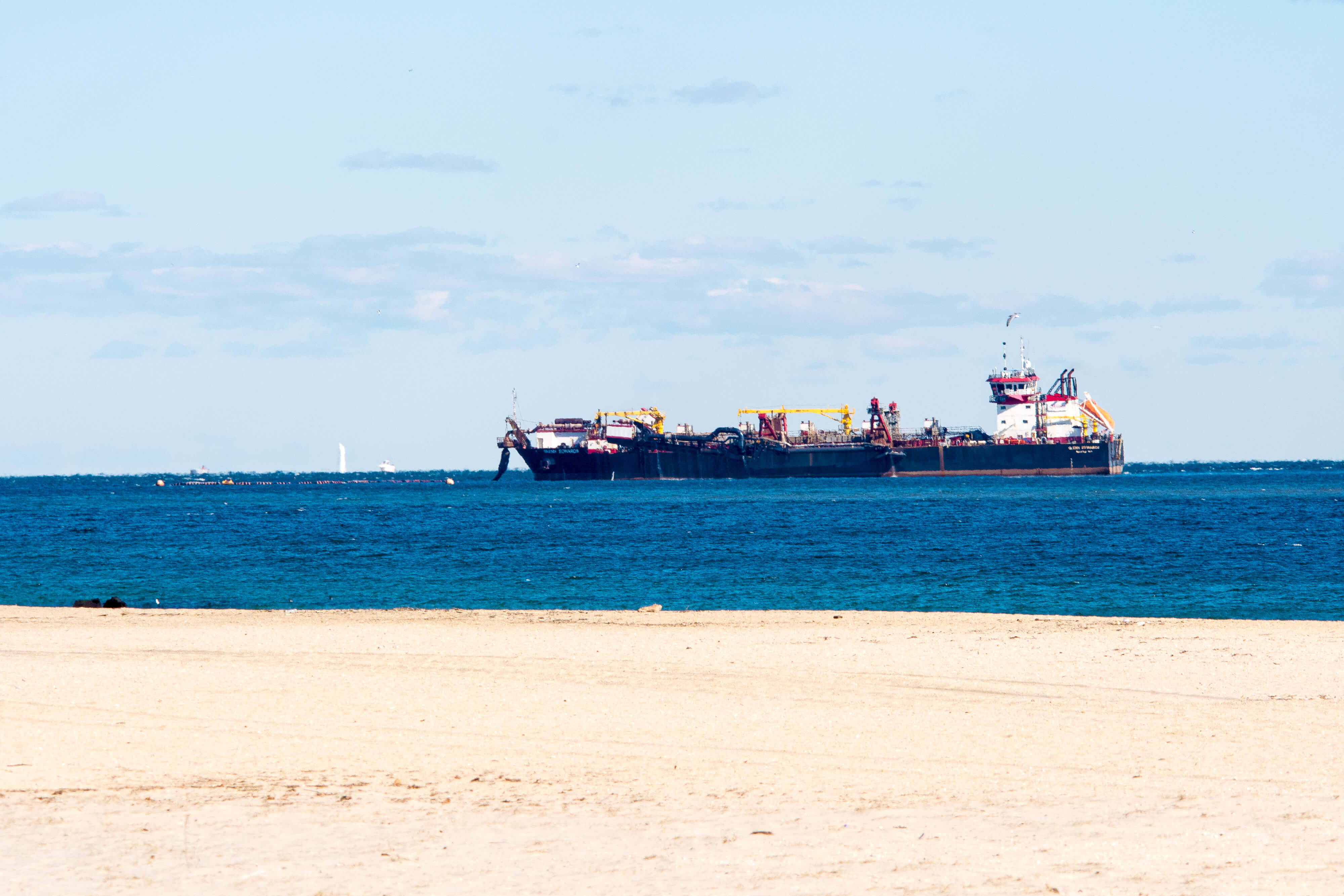
UCI Associate Director Tom Herrington moderated a webinar on May 30 that discussed how federal and state agencies can work together to ensure the best use of the Mid-Atlantic’s limited offshore and nearshore sand resources. The webinar focused on agency roles and responsibilities, best practices, and opportunities and impediments to beneficial reuse of sand and sediment in the region. Watch a recording of the session and browse informational materials related to the topic.
NOAA Digital Coast Highlights Monmouth University Class
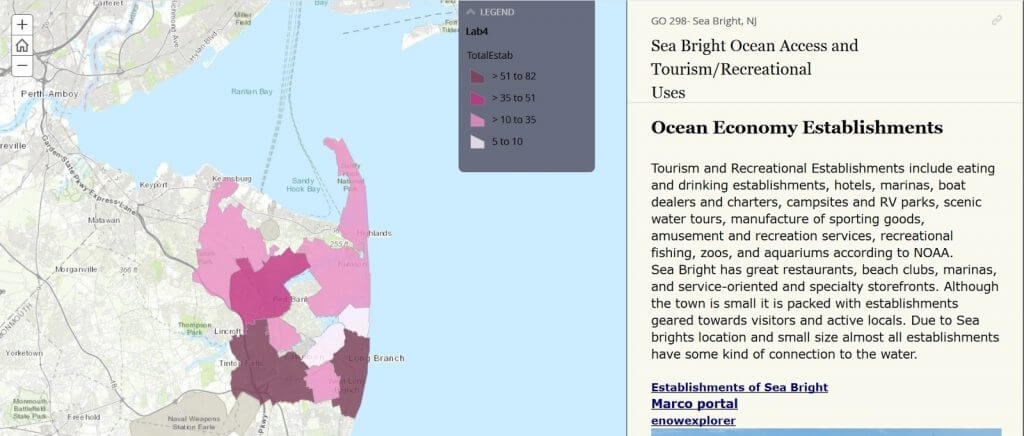
NOAA Digital Coast recently profiled Monmouth University’s Marine Applications of GIS class in its Stories from the Field section. The piece centers on how students used its data and tools in the creation of a series of story maps. You can read more about it here.
The course (GIS 336) will be available to Monmouth students again in the fall semester on Monday/Wednesday at 8:30 a.m. The 3-credit class is for anyone interested in how GIS is used for coastal or marine planning and can be applied as an elective to the marine and environmental biology and policy (MEBP) major or minors in geographic information systems, sustainability or related subjects. For more information, contact the course instructor, Jennifer Whytlaw, at jwhytlaw@monmouth.edu.
Webinar: Communities at Sea & Fishing Data
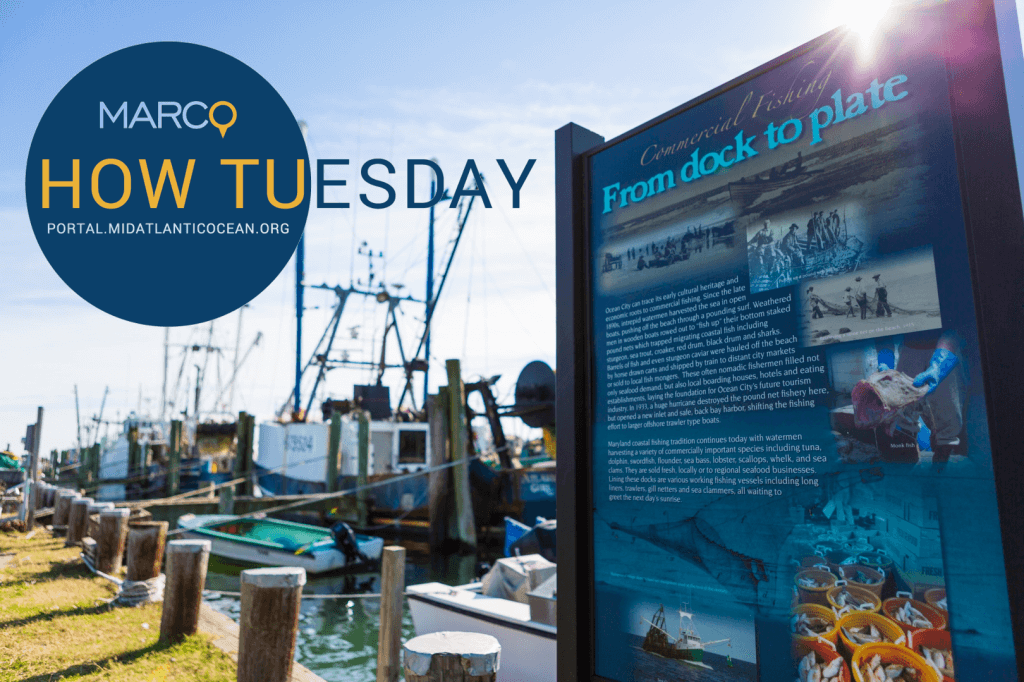
UCI Communications Director Karl Vilacoba co-hosted an instructional webinar on the Mid-Atlantic Ocean Data Portal’s extensive collection of commercial fishing maps on June 12. The UCI is a member of the project team developing the site under the guidance of the Mid-Atlantic Regional Council on the Ocean. Watch the session.
Video: Herrington Discusses Flooding Issues in Ocean City Area
UCI Associate Director Tom Herrington shared his thoughts on the past, present and future of barrier island flooding, as well as flood mitigation techniques and issues, with the public on June 6 at the Ocean City (N.J.) Library. Click the video above to watch his presentation, “Beyond Nuisance Flooding: Getting to Coastal Resilience in a Changing Climate.”
UCI Honored as Environmental Educators by EarthShare New Jersey
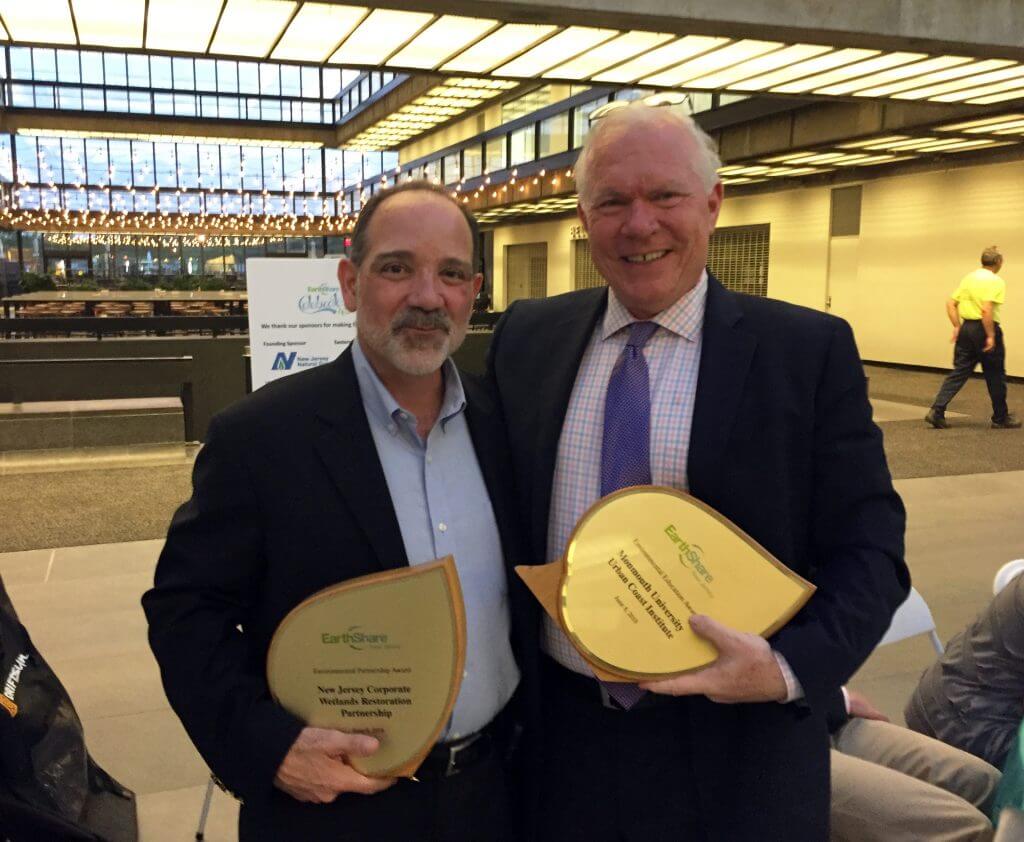
We couldn’t think of a better way to have spent World Oceans Day on June 8 than to have received EarthShare New Jersey’s Environmental Education Award at the legendary Bell Labs facility (now Bell Works). Above, UCI Director Tony MacDonald (right) is seen with the award and fellow honoree Russell Furnari, who accepted the Environmental Partnership Award on behalf of the New Jersey Corporate Wetlands Restoration Partnership. Furnari serves as a member of the UCI Advisory Committee.
